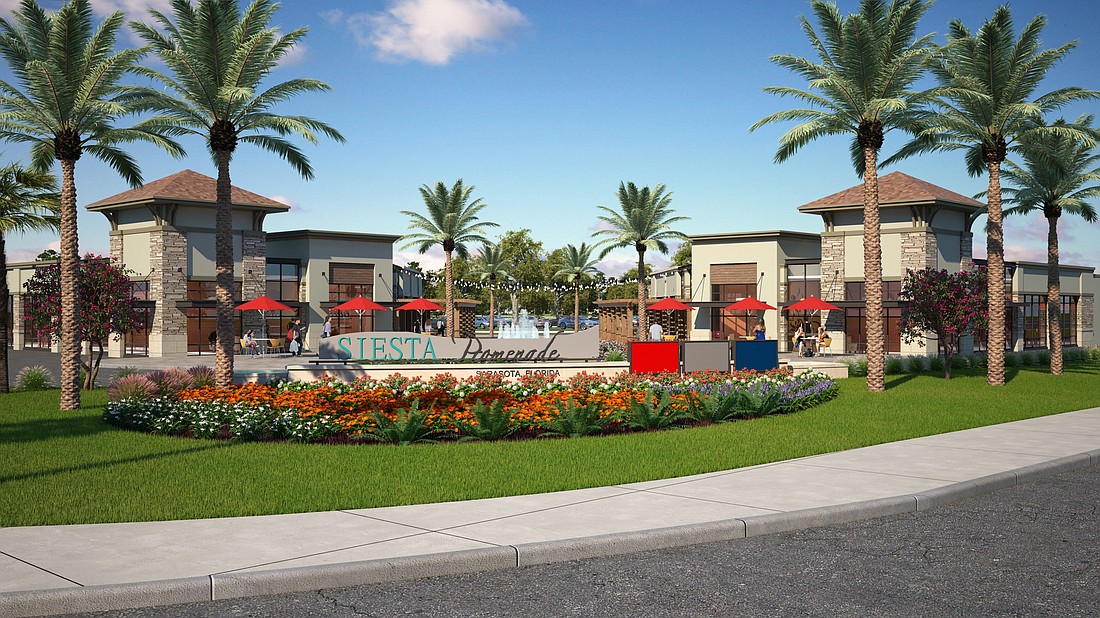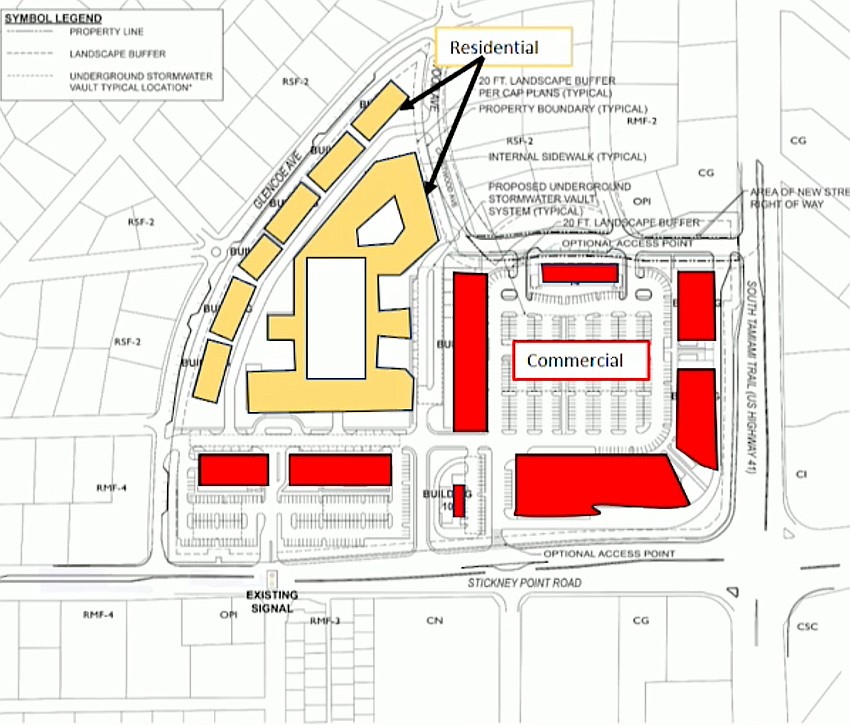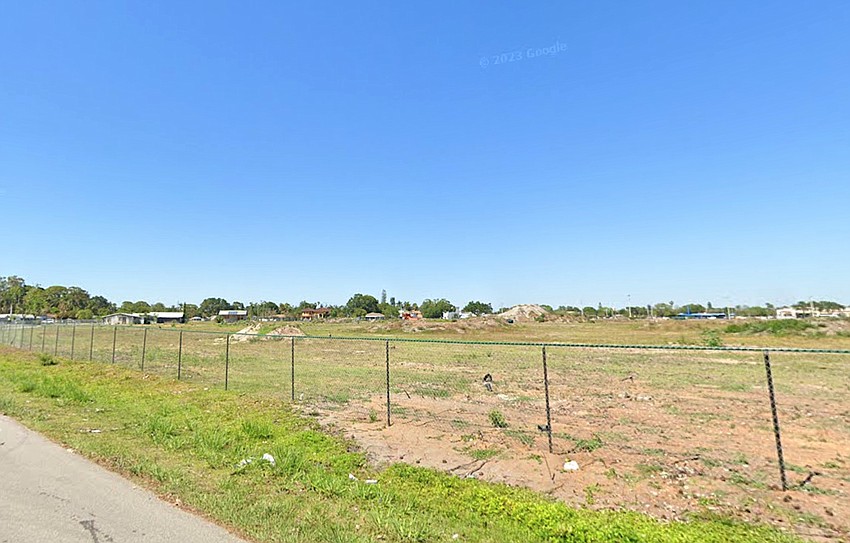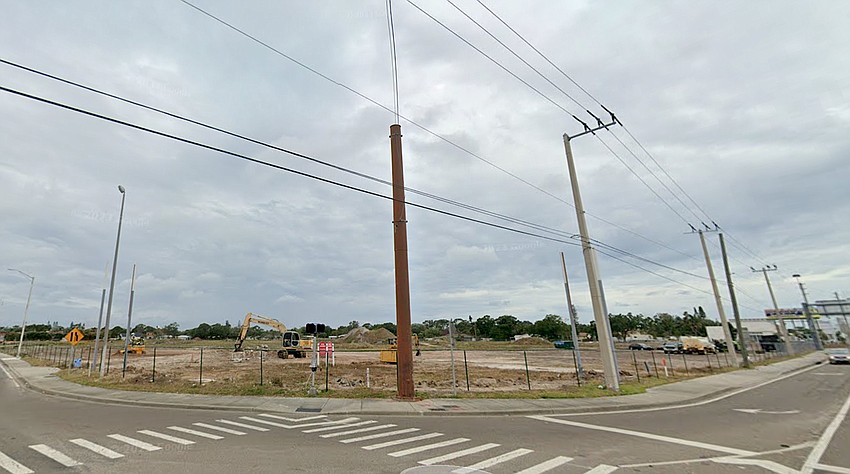- May 5, 2024
-
-
Loading

Loading

Since Benderson Development first proposed Siesta Promenade in 2014, there has been plenty of friction between the developer and residents of the adjacent Pine Shores neighborhood.
The 28-acre, mixed-use development at U.S. 41 and Stickney Point Road was approved by the Sarasota County Commission in 2018 and has prevailed in several legal challenges since. On July 20, Benderson was back before the Planning Commission, seeking a three-part recommendation for approval with only one aspect opposed by nearby residents.
They objected to a proposal to replace a planned landscaped buffer along Glencoe Avenue with 39 parallel parking spaces, which Benderson representatives said were essential to a number of traffic-calming measures between the development and the neighborhood.
The friction also rubbed up against the eventual vote — a 3-3 tie to approve applications for three small area amendments to the comprehensive plan, which included adding the parallel parking. Otherwise, the petitions addressed details related to adding two “hold out” parcels to the plan that added just more than three-fourths of an acre to the site.
A second motion that excluded the parallel parking measure was approved 5-1. The recommendation now goes to the County Commission, which has final approval.
The on-street parking plan was one of several traffic-calming measures suggested along Glencoe — another included a roundabout at the three-way intersection at Birchwood and Hazelton streets — but Benderson representatives called it an important one.

“I asked our consultants to look at the road and look at the requests and demands and the concerns and to do it the right way,” said Todd Mathes, Benderson’s director of development. “I understand you may not like parallel parking. … It has proven effective in slowing traffic down by creating friction.”
That plan created a different kind of friction with Pine Shores residents who said they felt betrayed when promised a landscaped buffer between the neighborhood and the project that includes 414 apartments, 130 hotel rooms and 140,000 square feet of retail and office space.
“On-street parking will create a new hazard that's not there today as moving cars pass parked cars and the doors of the parked cars are opened,” said Walter Rodak, who lives on Glencoe Avenue. “There’s already too much traffic on Glencoe Avenue. People drive on Glencoe for a variety of reasons. One of them is to take a shortcut from Tamiami Trail to Siesta Key, bypassing the traffic light. Now there's going to be another reason for people to drive on Glencoe to search for parking. It just multiplies my safety concerns.”
In exchange for the parallel parking, Benderson eliminated a driveway into Siesta Promenade from Glencoe Avenue, which it claimed would reduce traffic on the street.
The traffic-calming initiatives are part of the 2018 approval of Siesta Promenade. It required Benderson to engage with the neighborhood for input to measure the level of interest in and methods of traffic-calming measures and to reduce impacts of either pre-existing cut-through traffic or that which could be exacerbated as a result of the development.
Philip DiMaria, a planner with development consultant Kimley-Horn, said the thresholds of participation associated with garnering approval of traffic-calming methods prescribed in the county’s United Development code fell short, but they were devised regardless.
“It was our intent to still come through on the spirit of that stipulation in the 2018 approval and include traffic-calming methods,” he said.
Engineer Christopher Hatton of Kimley-Horn cited the Institute of Transportation Engineers, which reports parallel parking serves to slow traffic.
“What it does, generally, is it produces friction,” he said. “People when they're going down a road and they realize that there is parallel parking there, they realize that there might be a door open, so the purpose is to slow vehicles down and make people more conscious. You're going to pay attention, you're going to slow down, and you're probably not going to want to use that road.”

In addition to losing the landscaped buffer to on-street parking, residents who spoke before the Planning Commission cited a variety of safety concerns including fears of inviting more traffic into the neighborhood, spillover parking should parallel spaces be filled, multiple vehicle movements as drivers attempt to park, car doors opening into oncoming traffic, and more.
Mathes told commissioners the additional parking was neither needed by the project nor required by code to meet minimum parking thresholds.
“I sincerely believe that doing this is an improvement to the overall area,” Mathes said. “I understand there's some testimony. I understand there are opinions about angle parking and parallel parking and back-in parking and what it does, but what we know is that it creates friction on the road.
“We don't need the parking for the project. We're not proposing the parking for the project. But we are improving Glencoe Avenue with the mini-roundabout requested by the neighborhood at our expense. There are no impact fee credits. There's no compensation for it, even though it wasn't required as a result of the traffic-calming process.”
“I appreciate that,” replied Planning Commissioner T. Andrew Stultz. “I think the spirit of what you proposed is fine, but with regards to friction, I think the parallel parking is creating more than just traffic friction in this process.”
Don DeBerry, transportation director for the county’s Public Works Department, told commissioners that federal transportation data suggests there is no safety benefit to adding parallel parking where no parking currently exists.
“I do believe it's a traffic-calming measure. I do not believe it's safer than no parking,” he said. “I just looked up the crash modification factors from the federal crash clearing house. They only have two studies on adding parallel parking where there is none. Both of those studies propose a method that would indicate that it's less safe than no parallel parking.
“With respect to angle parking versus parallel parking, parallel parking does study to be safer than angle parking. So with respect to that, is it traffic-calming? Yes. Is it safer than what's there now? No.”
Planning Commissioner Emmalee Legler, who was the most outspoken against the parallel parking, made the substitute motion following the deadlock of the original motion to approve Benderson’s applications in total.

“Parking has all of a sudden become the forefront of this particular petition, and I don't think that that was nearly the intent of what you guys we're doing here today,” Legler said. “The neighborhood is saying we don't want parallel parking here, and Benderson says (they) would like to do that in order for it to be a safer place for the neighbors. Proceeding with what we're here for tonight without the parallel parking accommodates what the neighborhood is looking for, and also accommodates what you guys are looking for.”
Added Stultz, “I’m not sure if parallel parking is a hill we all want to die on.”
The Planning Commission’s recommendation for approval of Benderson’s petitions minus the parallel parking plan doesn’t mean it won’t happen. The measure will go before the County Commission for final consideration.
Legler urged Pine Shores residents and other concerned citizens to attend that meeting, which has yet to be sheduled.
“I do encourage the community to go to the Board of County Commissioners meeting when this is slated because they are the second half of this process,” she said.